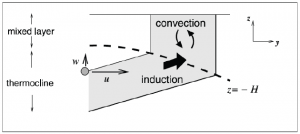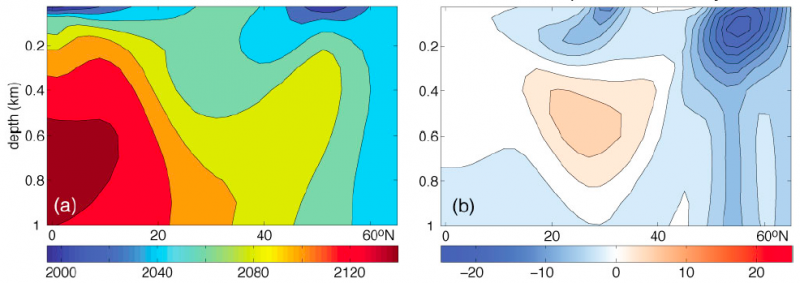HPCCprojects:The impact of thermocline induction on decadal variability of the North Atlantic carbon sink
The impact of thermocline induction on decadal variability of the North Atlantic carbon sink
Project description
| Induction schematic of Williams et al. (2006). |
Remotely sensed and in situ data suggest that ocean biological productivity and carbon uptake are changing, but we are challenged to distinguish between anthropogenically-forced trends and natural decadal timescale variability. We need to enhance our capacity to make these distinctions so that we can better inform climate change mitigation and adaptation decision-making.
In this project, we will quantify the impact of ocean circulation-driven variability in carbon and nutrient induction on observed changes in surface ocean productivity and air-sea carbon dioxide fluxes in the North Atlantic. Induction, an injection of fluid and tracer from the permanent thermocline across the sloping base of the seasonal mixed layer, has been shown to be many times larger than Ekman upwelling and dominant to surface ocean nutrient renewal. Based on preliminary results, we propose that a spin-down of the subpolar gyre, associated with the negative trend of the North Atlantic Oscillation from the mid-1990s to the mid-2000s, led to substantial reductions in induction of nutrients, dissolved inorganic carbon (DIC) and alkalinity (ALK). In turn, the declining induction caused (1) productivity declines, as observed in the satellite record, and (2) declines in surface ocean DIC and ALK that have caused a pCO2 reduction that has approximately balanced pCO2 increases driven by warming sea surface temperature (SST) over the same period.
| Idealized model, upper ocean DIC in the northern hemisphere. (a) Annual-mean, zonal-mean DIC from a control simulation, and (b) anomalies of DIC during a subpolar gyre spin-down experiment (μmol kg-1). |
Objectives
The objectives of this project are to (1) perform a joint analysis of satellite and ocean state estimates, (2) perform idealized modeling experiments, and (3) analyze realistic hindcast models in order to address the following science questions:
- Question 1: To what degree does nutrient, DIC and ALK induction at the base of the wintertime mixed layer contribute to surface ocean tracer budgets, their temporal variability, and related biogeochemically-relevant fluxes?
- Question 2: How do subpolar gyre spin-down and spin-up modify tracer induction?
- Question 3: What is the net effect of subpolar gyre spin-down and spin-up on the carbon sink of the North Atlantic?
Time-line
| Start date: | 01/01/2011 |
| End date: | 12/31/2013 |
Models in use
MITgcm: idealized modeling of the North Atlantic subpolar gyre circulation and carbon fluxes
Results
Results coming soon...
Users
Funding
NASA
Publications and presentations
Coming soon...
Links
Coming soon...


